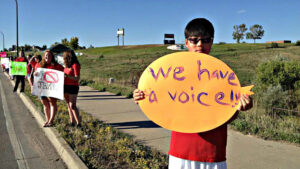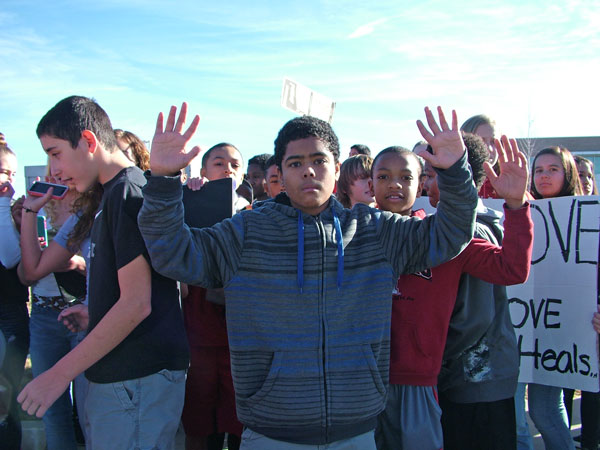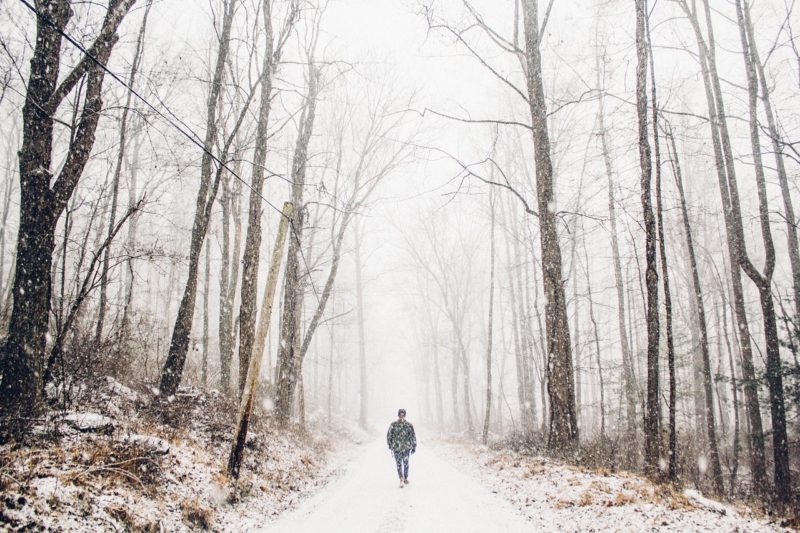- What is a poem?
When I teach poetry, I often begin by asking students what a poem is. Their answers are ones I’ve come to expect: a poem has line breaks. It shows your emotions. It rhymes, or it doesn’t. It has fancy language. It’s hard to understand.
Last fall, I began my T&W residency at IS 392 with that question, with a lesson I’ve used time and time again. In the next part of the lesson, I hand out strips of paper with different definitions of poetry. A poem is a verbal contraption (Auden), a poem is the evidence of life (Leonard Cohen), a poem is that which helps us live (Wallace Stevens). The idea is to open the students’ understanding of what a poem can be, to open it wide enough that they find space to enter the world of poetry themselves. I ask students to agree and disagree with the definitions, and to write their own.
That first day at IS 392, one of my new students picked a quote from Pablo Neruda: poetry is an act of peace. And when that student read out Neruda’s line, they said, I disagree.
It’s a lesson I’ve used time and time again, but this was not just any time-it was November 7, 2016. The day before the election. And this student, bold enough to disagree with Neruda on the first day of class, insisted that poetry was not about peace, but protest.
For these students, both poetry and politics were inextricable from their current realities. What I had thought of as “political context” was simply daily life for these middle school students. It wasn’t up to me to bring it into the classroom-it was already there.
- Written by Themselves
I didn’t return to the school until two weeks later. The immediate aftermath of the election had passed, and now the hallways were papered with assignments and projects responding to a changed America.
During the first classes that I taught post-election, I asked my students to write not about America, but about themselves. I brought in a poem by Gregory Pardlo, a Brooklyn poet and a recent recipient of the Pulitzer Prize in poetry. IS 392 is in Brownsville, Brooklyn, and I wanted the students to read poetry that came from a place that they knew. Pardlo’s poem “Written by Himself” takes on the question of the speaker’s own beginnings, with a refrain that runs through the poem: I was born.
Most of my students were born in Brooklyn, not far from the classroom they were sitting in. If you look at the Wikipedia entry for Brownsville, you quickly learn that “It has consistently held one of the highest poverty and crime rates of any neighborhood in New York City.” The neighborhood is predominantly black, with a substantial Hispanic population as well. In short, Brownsville was one of the neighborhoods that Trump, on his campaign trail, referred to as “the inner city,” a place he described as a “disaster,” with a sweeping rhetorical hand that denied the existence of any individuals like the students who were seated in front of me in class.
I asked the students to fold little cardstock tents so I could call them by their names: Destiny, Devin, David, Deshaun. I asked them to stand up when they read so that the whole classroom would hear. And yes, some days they were raucous, and they spoke out of turn and misbehaved. But they were also earnest, eager. There was a sense of urgency in each class.
As we discussed Pardlo’s poem, I asked students to think about its refrain, the repetition of I was born. I posed a question: Why do people ask where you were born?
Because they want to know more about you, one student said.
Another student raised their hand: Because they think you don’t belong.
In an interview for The Conversant, Pardlo suggests that his poem might prepare the reader for a “wrestling with selfhood,” and I saw just that in my students’ poems. They were wrestling with selfhood even as they knew that the President-Elect could put their very selves at risk.
A sixth-grade student, Iyanna, wrote this poem:
I was born where nothing is free
I was born where nothing is free. I was born where there is violence going on we need to come
To an end. Even though some holidays are meant for coming together we should get together
Every day. We are all family. Color or not. We should not go against each other we should work together.
I was born where wishes do not come true even though you wish they would.
I was born where you can’t trust a lot of people.
I was born where when you want something you work hard for it and you own it.
I was born where it’s really crowded with people.
I was born where things were unfair and people didn’t give a care.
I was born where things aren’t that fancy and nice.
I was born where you might want to think twice.
Mackalia, in seventh grade, wrote a prose poem:
I was born on December 14, 2004, it was cold. I was born in a hospital and for three days my mom had to stay with me because I had asthma. I couldn’t breathe. It was like a dark hole. I was born as a quiet sad child. I was born lost and afraid. I was born in fear of myself and my emotions. I was born like a porcelain doll. I was born in a place that you would think had more hope and made your heart like a dismal hole. I was born trying to figure out my purpose. I was born learning the American Dream is not a dream but a nightmare. I was born with despair and vengeance in my heart. I was born with fear of a tall brown chair. I was born like a dark angel tied to the chains of earth. I was born as the dismay of my mother. I was born. I was born. I was born to be me.
Though each of these poems, and many others written by these students, carries a sense of hardship, I was most struck by the resilience that is woven through. As they wrote about themselves, they were re-asserting their own selfhood. We are all family. Color or not. I was born. I was born to be me.
Over the next weeks, students took different approaches to writing about their identity. I asked them to bring in an object of personal significance, and they wrote self-portraits as that object. Of course, some students forgot to bring something in, and cleverly produced “significant objects” from their pencil cases. One such smart student chose his calculator as the subject of his poem, and wrote “Self Portrait as Calculator,” a poem that began:
My skin color is Black and my personality is useful
My race is an electronic and my location is in stores
My life is a battery but that makes me heavy
And if I am not charged I will die
Students wrote about their skin, their hair, the physical being of themselves, even as they were writing about calculators, iPhones, objects from their homes. I came to see their poems not as acts of peace, but acts of survival, defenses of the self. Every time they put pen to page, they were still more eager to speak their words aloud, to give voice to their own identities. Sometimes a poem read aloud to the class would gain such momentum and force that it felt more like a speech at a rally than a poem, and the other students would rally around the writer with calls of approval and support. In the most moving cases, the overlapping chatter of middle-schoolers would fall into a silent solidarity.
In eighth grade, Ajmaani wrote a brief poem that captured the sentiment of many of the student self-portraits:
A Body Is…
A body is filled with emotions.
Bent, worn out and broken.
A body is filled with worry,
When the world becomes blurry.
I want to believe, soon I’ll be
Free. The air gets tight my head
Becomes light.
- Beyond the Years
Over the course of my residency at IS 392, the prompt that the students took hold of with the greatest passion was when they were asked to write about the future. It was our first class of the new year, January 10, just ten days before the Inauguration. The Internet was flooded with memes about the horrors of 2016, and predictions for what 2017 might hold.
We read Paul Laurence Dunbar’s “Beyond the Years,” and I told the students the story of one of America’s first nationally-recognized black poets. Up until this point, every time one of the poets we read together was revealed to be black, there was a ripple through the room of students-a surprised recognition that a poet might resemble them, or more important still, that they might resemble poets.
Paul Laurence Dunbar was born in 1872, less than a decade after the end of the Civil War. His parents were freed slaves. At age 14, around the age of my IS 392 students, Dunbar began publishing poems. That was not the case all those years ago. It was while working this job as an elevator operator that he self-published his first book, which he sold for a dollar to people riding his elevator up or down. He went on to publish short story collections, novels, and several more collections of poems, gaining national acclaim, and even publication in the New York Times before he died of pneumonia and tuberculosis at the age of 33.
I asked my students to consider the fact that, for Paul Laurence Dunbar, we were far “beyond the years,” more than a hundred years beyond his writing of this poem, beyond his life, and his early death.
I asked my students to imagine a time beyond their own years-be it 10 years, 30 years, or even 300 years into the future.
The poems that they wrote confirmed some enduring truths about our vision for what lies ahead: We are all still dreaming about flying cars and robots that will do our chores. But the futures they envisioned were also deeply colored by their particular moment, in early January of 2017, with the Inauguration of Donald Trump no longer a distant future, but an inevitable present.
In eighth grade, Jahmarlo and Isaiah wrote a poem for the year to come:
New Look Into 2017
Omg can’t you see it’s 2017 and we’re still not free.
We just need time, time is all we got.
It will move on without you whether you like it or not.
There are still African American children getting shot.
They say it will get better but I don’t see improvement.
Get out take a stand and join the movement.
R.I.P. 2016 I give you my condolence.
Use the bad times as a notion to keep going.
In sixth grade, Auriana imagined the future as a world with less violence, “and maybe a world with me as the first black female president.” “Close your eyes,” she asked her reader, “and imagine/ A place you pay more taxes/ A place where everyone is equal and treated the same/ A place where everyone is a star without hate/ And maybe a place with children with bigger attitudes/ But people with gratitude.”

Maxwell, a sixth-grader, wrote an optimistic but measured poem that ended with these careful lines: “In 10 years from now I may not know what will happen but I know it will be worth the wait.” In eighth grade, Leilani closed her poem about the future with a couplet: “We never know but coming together is what we know for sure/ Sometimes we have to lose the small fights to win the war.”
Every vision of the future that these middle-schoolers penned was tethered to the present with the forces of grief, and hope, and fear. In eighth grade, Christopher wrote a poem called “Way Beyond the Years”:
Way Beyond the Years
Way beyond the years we might find peace
We might fulfill Martin Luther’s dream,
We might not ever have to grieve
But don’t hold your breath in 2017
There’ll be more drama, more stupid trends
More dead bodies on the news again
Less people concerned about staying alive
And more obsessing over KardashiansMore countless robbers with a lot of loot
More home invasions where they get the boot
Less unity in the community and
WAY MORE “hands up don’t shoot”
More trash rappers sitting in the booth
More companies that corrupt the youth
More fake religious people always at
The club asking hmm What Would Jesus DoMaybe one day we could finally fly
Maybe no one in my family would die
Maybe I’d never have to break down and cry
Maybe in the future somewhere in the future,I could finally let go of what’s already left behind
- But what is a poem?
Poetry is protest. Those words from a student on the first day of class would resound in my mind through every lesson that I taught, as together we discovered what it means to write in a time of political uncertainty and upheaval. What is a poem, now?
In the months that followed the election, news outlets published a steady stream of projections for the Trump presidency-predictions, warnings, speculations, and every form of fear. But in all of this, the major news outlets did something surprising: they also began to publish poems.
One sixth-grade student, Chaniyah, wrote a poem inspired by a Henri Cole quote: a poem is organized violence. Her poem begins:
Poetry is organized violence.
Poetry is what made violence all over the streets
This started the ANTI-Trump group and march
This is what made those terrifying fires happen
A seventh-grade student, Shaniah, wrote:
Poetry is a blind bird singing along with the trees.
It can be as crooked as Donald Trump’s mind, or as straight as a ruler.
It can make you angry or sad, or you will enjoy it and become glad.
In all the poems that IS 392 students wrote between November of 2016 and February of 2017, I was struck by the qualities of candor and strength. These were students who were writing with direction: writing against their own realities, writing for their own futures. These poems were risks, risks as real as every other part of their lives. Yaritza in sixth grade captures it better than I ever could:
You Risk Your Life
You step outside you risk your
life. You take a drink of water
you risk your life. You
breathe you risk your life. You speak you
risk your life. You sleep
you risk your life. If you look at someone
you risk your life. You smell
you risk your life. You run you risk you
risk your life. You don’t work
you risk your life. You eat you risk your
life. You drive you risk your
life. You walk you risk your life. You try to
forgive someone you risk
your life. You dance you risk your life. You
sing you risk your life. You
bleed you risk your life. The future, that
you can risk your life in.
I began my residency at IS 392 by asking students what a poem is, and by the end, I had far more answers than I could have imagined. The anthology of student work gathered poems that were acts of protest, expressions of distrust or despair, reassertions of self, and constructions of hope. But the best way to describe these poems may be to turn to the words of a student again. In a span of months where many of us felt overwhelmed, powerless, and fearful, Kayla in seventh grade wrote: a poem is your world that you can control.
Teachers & Writers Collaborative thanks Leonore Gordon, Myra Kooy, and the Leonore Gordon PD Arts and Wellness on the Go Fund at Stonewell Community Foundation for their generous support of T&W poetry programs at IS 392.
Photo (top) Credit: Villager Publishing



